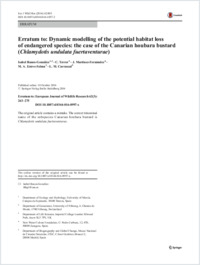Dynamic modelling of the potential habitat loss of endangered species: the case of the Canarian houbara bustard (Chlamydotis undulata fuerteventurae)
- Banos-González, Isabel Department of Ecology and Hydrology, University of Murcia, Spain - Department of Geoscience, University of Fribourg, Switzerland
- Terrer, C. Department of Life Sciences, Imperial College London, Ascot, UK
- Martínez-Fernández, J. New Water Culture Foundation, Zaragoza, Spain
- Esteve-Selma, M. A. Department of Ecology and Hydrology, University of Murcia, Spain
- Carrascal, L. M. Department of Biogeography and Global Change, Museo Nacional de Ciencias Naturales, CSIC, Madrid, Spain
-
20.02.2016
Published in:
- European Journal of Wildlife Research. - 2016, vol. 62, no. 3, p. 263–275
chlamydotis undulata fuerteventurae
habitat loss
threatening factors
dynamic model
arid island
scenarios
English
In this work, we apply a dynamic modelling approach to analyse the habitat loss of the Canarian houbara bustard (Chlamydotis undulata fuerteventurae). This tool allows us to assess the effects of the socio-economic and environmental interactions on the factors threatening the habitat and to carry out a prospective analysis. The results show a potential habitat loss of around 13 % during the period 1996–2011, the land uptake and increase in new roads and tracks being the factors contributing most. After model testing, a set of scenarios was explored. Under the business as usual (BAU) scenario, around 20 % of the habitat would be lost by the end of the period considered (2012–2025). The impact of the economic growth scenario on the habitat would mean an additional loss of around 21 % with respect to BAU, whereas under the recession scenario, the loss might be around 6.5 % lower than BAU. The policy of restoration of gavias—traditional farming systems—would suppose an additional loss of almost 6 %, relative to BAU. If this policy took place under economic growth conditions, it might mean an additional loss of almost 28 % relative to BAU. These results point to the existence of a potential trade-off between the recuperation of ecosystem services offered by restored gavias and the conservation of the houbara habitat, which must be addressed within the management processes, as well as to the need for compensatory measures to guarantee the conservation goals.
- Faculty
- Faculté des sciences et de médecine
- Department
- Département de Géosciences
- Language
-
- English
- Classification
- Ecology and biodeversity
- License
- License undefined
- Identifiers
-
- RERO DOC 261104
- DOI 10.1007/s10344-016-0997-x
- Persistent URL
- https://folia.unifr.ch/unifr/documents/305144
Other files
Statistics
Document views: 86
File downloads:
- ban_dmp.pdf: 200
- ban_dmp_sm.pdf: 120
- ban_dmp_err.pdf: 110


